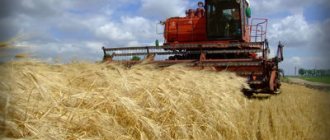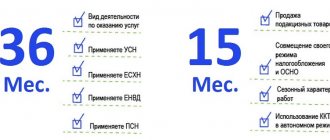The essence of the Unified Agricultural Tax tax 2021
The Unified Agricultural Tax system itself is one of 5 special tax regimes that are available to small businesses. Let us consider the very essence of the Unified Agricultural Tax special regime.
From the name it is clear that this tax relates to agriculture.
By choosing the Unified Agricultural Tax tax in 2021, you automatically get rid of taxes such as VAT and income and property taxes that are on the OSNO (general taxation system).
Agricultural activities for which the Unified Agricultural Tax can be applied:
- Plant growing;
- Livestock;
- Poultry farming;
- Fish farming.
In other words, the special tax regime of the Unified Agricultural Tax replaces the OSNO tax. And in this case it is necessary to report specifically on the Unified Agricultural Tax.
The Unified Agricultural Tax can be applied in conjunction with the UTII or PSN tax. In this case there will be separate taxation.
Despite the fact that it is allowed to use special UTII and PSN regimes with the Unified Agricultural Tax, the share of agricultural business must be at least 70% of the total business.
Responsibility for late filing of a declaration under the Unified Agricultural Tax
For late submission of a declaration to the tax authorities or its absence, the following sanctions are provided:
- for violation of the deadline for filing a declaration, penalties are provided in the amount of 5% of the tax amount for each overdue month, but not more than 30% (Article 119, paragraph 1 of the Tax Code of the Russian Federation);
- failure to comply with the procedure for filing an electronic declaration - 200 rubles (Article 119 of the Tax Code of the Russian Federation);
- Violation of tax payment deadlines - 20% of the accrued amount. In case of intentional action - 40% (Article 122 of the Tax Code of the Russian Federation);
- for failure to provide a document required by a tax officer within 5 days, a fine of 200 rubles is provided for each document (Article 126 of the Tax Code of the Russian Federation);
- in accordance with the Administrative Code (Administrative Code), for minor administrative offenses a fine of 300 to 500 rubles is imposed on officials (Article 15.5 of the Administrative Code).
The 1C accounting program copes well with the preparation of reporting materials according to the unified agricultural taxation form. Experience shows that problems can arise with the posting of bank and cash documents. When reimbursing social benefits, the program automatically enters the transfer into the income portion subject to taxation. The adjustment has to be done manually, but calculating the tax is not as difficult as it might seem, because the future lies in automated document processing.
How to switch to the Unified Agricultural Tax in 2021
Switch to the Unified Agricultural Tax in 2021; you can submit a notice of application of the Unified Agricultural Tax until December 31, 2017, and in this case you can begin to apply the Unified Agricultural Tax from 01/01/2018.
I recommend submitting the notification itself somewhere on December 15, 2017, in order to be sure to receive permission to use the Unified Agricultural Tax in 2018. You do not have to wait until the last day, since you may not have time to register and you will not receive the right to apply the Unified Agricultural Tax.
Also, when submitting a notification about the transition to the unified agricultural tax, it is necessary to indicate the share of the agricultural business, as I said before - at least 70%.
Also, organizations and entrepreneurs who have just registered can switch to the Unified Agricultural Tax tax in 2021 - they are given 30 days to do this.
If organizations and entrepreneurs do not provide notification within the established time frame, then they do not have the right to apply the Unified Agricultural Tax.
When the Unified Agricultural Tax tax cannot be applied
- If the tax inspectorate refuses the right to apply a single agricultural tax;
- When the deadlines for submitting a notice of transition to the unified agricultural tax are violated;
- In the event that, at the end of the period, the taxpayer ceases to comply with the requirements of the special regime of the Unified Agricultural Tax.
If a taxpayer, being in the special unified agricultural tax regime in 2021, ceases to meet the requirements for which the unified agricultural tax is allowed to be applied, then he must notify the tax authorities about this within 15 days.
Who can apply the special regime of Unified Agricultural Tax in 2017
Taxpayers of the special regime of the Unified Agricultural Tax can be entrepreneurs, organizations and peasant farms that are agricultural producers.
Producers of agricultural products can be:
- Peasant farms (peasant farms);
- IP (individual entrepreneurs);
- LLC (limited liability company).
Regardless of the chosen form of ownership: peasant farm, individual entrepreneur or LLC, they must meet the following requirements:
- Produce agricultural products;
- Carry out primary processing and subsequent industrial processing of agricultural products;
- Sale of agricultural products.
All these requirements must be met simultaneously, that is, for example: you cannot simply sell agricultural products on the Unified Agricultural Tax.
All requirements are complex in nature and if they are violated, the entrepreneur is deprived of the right to apply the Unified Agricultural Tax.
Further, as I mentioned earlier, the share of agricultural business turnover should not be less than 70% of the total turnover of the organization.
Fishery organizations also have the right to apply taxation under the Unified Agricultural Tax.
Mandatory conditions for the transition to the Unified Agricultural Tax in 2021:
- The average number of employees should not exceed 300 people;
- 70% - the total turnover from the organization's activities.
The following organizations cannot apply the Unified Agricultural Tax:
- State, budgetary, as well as autonomous institutions;
- Organizations producing excisable goods;
- Organizations involved in the gaming business.
Reporting and tax payment
All business entities calculating the unified agricultural tax must submit a tax return under the Unified Agricultural Tax based on the results of the calendar year.
This can be done by the director of the company, entrepreneur, or their authorized representatives at a personal meeting, by registered mail or using electronic document management via the Internet.
You might be interested in:
Code of type of entrepreneurial activity UTII in [year] year and basic profitability
The tax return for the unified agricultural tax is sent to the Federal Tax Service once before March 31 of the year following the end of the reporting year.
If, due to any reason (violation of conditions, termination of activities, etc.) the taxpayer stops using the agricultural tax, the Unified Agricultural Tax declaration is submitted by the 25th day of the month after the month of termination of use of the system.
Since both income received and expenses incurred are used to determine the amount of tax, to confirm them, each entity must draw up a ledger of income and expenses. Its sheets are numbered in order, then stitched and sealed. Entries in the book are made sequentially, in chronological order, based on the documents actually received.
It is allowed to make corrections to the book if there is an error. However, each such event must be accompanied by a visa from the responsible specialist and a seal (if used). The erroneous value is crossed out with one line so that it can be easily read.
Thus, agricultural tax taxpayers must:
- Provide a declaration under the Unified Agricultural Tax by year. This must be done before March 31 of the year following the reporting period.
- Keep a book of income and expenses.
Attention! Agricultural tax is transferred to the budget during the year in two amounts. After the end of the first half of the year, until July 25, based on its results, the taxpayer must determine and transfer an advance payment to the budget. Further, after the end of the calendar year, the full amount of tax is calculated, which is reduced by the previously paid advance payment and is also sent to the budget by March 31.
Tax rate of the Unified Agricultural Tax
Let's look at what the Unified Agricultural Tax rates are:
- Standard tax rate for Unified Agricultural Tax in Russia = 6%;
- Unified agricultural tax rate for Crimea and Sevastopol from 2021 to 2021 = 4%.
How to calculate the amount of the Unified Agricultural Tax in 2021
Let's look at how to calculate the Unified Agricultural Tax:
Unified Agricultural Tax for Russia = tax base * 6%;
Unified agricultural tax for Crimea and Sevastopol = tax base * 4%.
How does the Unified Agricultural Tax system work?
Legal entities are required to keep records of the organization’s performance indicators. On their basis, the tax base and, in fact, the tax itself will be calculated.
The Code does not establish such an obligation for entrepreneurs. However, they are required to monitor how work is progressing and record income and expenses in the accounting book. It is filled out in accordance with the form established by Order of the Ministry of Finance No. 169n.
The work of the tax system includes the following components.
- The reporting period is 6 months.
- The tax period is 12 months.
- Tax rates – 6%.
- The advance payment date is no more than 25 calendar days after the end of the reporting period.
- The tax base is the amount of income of an enterprise reduced by expenses.
back to menu ↑
Unified agricultural tax reporting in 2021
Since the tax period for the Unified Agricultural Tax is 1 year, once a year it is necessary to submit a tax return for the Unified Agricultural Tax and prepare a KUDiR book for reporting purposes.
- For organizations (LLC) – the deadline for submitting the Unified Agricultural Tax declaration is March 31, 2018;
- For individual entrepreneurs and peasant farms, the deadline for submitting reports in the form of a Unified Agricultural Tax declaration is April 30, 2021.
That's all I wanted to tell you about the single agricultural tax in 2021.
If you have any questions, please ask them in the comments or in my VK group “ ”. Happy business to everyone! Bye!
Calculation of single tax using an example
The single agricultural tax is calculated using a simple formula:
St x B,
where: St - tax rate;
B - tax base.
The rate in this case is 6%. The tax base is income reduced by the amount of expenses (clause 1 of Article 346.6 of the Tax Code of the Russian Federation). Income and expenses are taken into account on an accrual basis from January 1 of the tax period.
As income, income from sales and non-operating income determined in accordance with Chapter. 25 Tax Code of the Russian Federation.
An enterprise can reduce revenue received by expenses incurred, for example:
- for expenses associated with the purchase and overhaul of fixed assets;
- office;
- expenses for the purchase and creation of intangible assets;
- rent and leasing payments;
- material costs;
- remuneration of hired personnel;
- compulsory and voluntary insurance;
- fire safety expenses;
- transportation costs, including maintenance of vehicles;
- travel expenses;
- services of accounting, lawyers, auditors and notaries;
- communication services, postal and telegraph expenses;
- carrying out various types of examinations;
- commissions;
- advertising, etc.
A complete list of such expenses can be found in paragraph 2 of Art. 346.5 Tax Code of the Russian Federation. Agricultural organizations also have the right to take into account losses from previous years as expenses.
Let's look at a simple example of calculating the “agricultural” tax. All data in it is conditional.
Example
IP Asatin A.S. is engaged in fishing activities (fish breeding) for the subsequent sale of products. From 2021, it applies a taxation system for agricultural producers.
Initial data for 2021:
- Revenue from the sale of farmed fish for 2021 recognized in accordance with Sec. 25 of the Tax Code of the Russian Federation, - 9,000,000 rubles.
- Expenses for 2021 recognized in accordance with paragraph 2 of Art. 346.5 of the Tax Code of the Russian Federation, - 6,500,000 rubles. This includes material costs, labor costs for hired personnel, business trips, costs for maintenance and upkeep of equipment (fixed assets), transportation, etc.
- Loss for 2021—RUB 200,000.
- Payment of single tax (advance payment for the 1st half of the year) - 20,000 rubles.
- Payment of single tax (advance payment for the 2nd half of the year) - 30,000 rubles.
We will calculate the amount of tax to be transferred to the budget.
- We determine the tax base: 9,000,000 – 6,500,000 = 2,500,000 rubles.
- We reduce the tax base for the 2021 loss: 2,500,000 – 200,000 = 2,300,000 rubles.
- We calculate the amount of single tax for 2021: 2,300,000 x 6% = 138,000 rubles.
- Let's calculate the final amount of single tax to be transferred to the budget for 2021. To do this, subtract the amount of advance payments: 138,000 – 20,000 – 30,000 = 88,000 rubles.
So, individual entrepreneur A.S. Asatin must transfer 88,000 rubles to the budget by March 31, 2022. By the same date, he must submit a tax return for 2021.
On the grouping of expenses for profit tax purposes, see the article “The concept of expenses and their grouping according to the norms of Article 252 of the Tax Code of the Russian Federation.”
Tax exemption
Organizations that have switched to paying the Unified Agricultural Tax are exempt from the obligation to pay:
- corporate income tax;
- corporate property tax;
- value added tax (with the exception of VAT payable when importing goods into the territory of the Russian Federation and other territories under its jurisdiction).
Individual entrepreneurs who have switched to paying the Unified Agricultural Tax are exempt from the obligation to pay:
- personal income tax (in relation to income received from business activities);
- property tax for individuals (in relation to property used for business activities);
- value added tax (with the exception of VAT payable when importing goods into the territory of the Russian Federation and other territories under its jurisdiction).
Other taxes and fees are paid in accordance with the legislation of the Russian Federation on taxes and fees.
Please pay attention!
Organizations and individual entrepreneurs who are payers of the unified agricultural tax are not exempt from performing the duties of tax agents.








